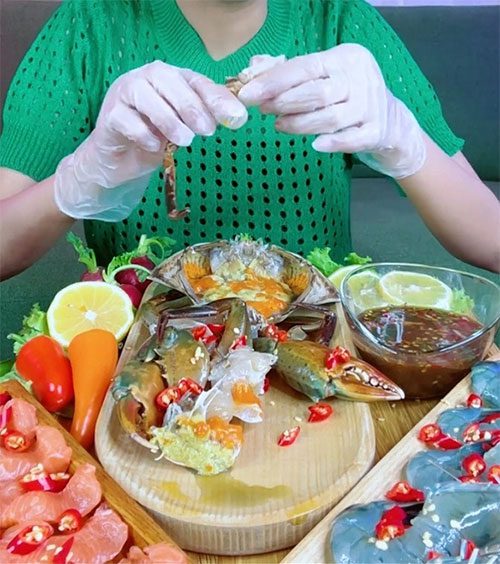Videos showcasing enormous meals or bizarre food combinations are flooding the internet, raising concerns among experts about a potentially harmful trend that could lead to eating disorders.
Sitting in front of a large spread of food, a female TikToker with over a million followers begins filming her mukbang video. Mukbang is an online food trend originating from South Korea, where the host eats large quantities of food live on camera while interacting with viewers.
The spread includes various live seafood such as octopus, lobster, and oysters, along with a large serving of dried beef salad, all of which the young woman finishes in under 10 minutes. In the video, viewers can clearly hear the sounds of biting, chewing, and crunching, creating different auditory effects. The video has garnered millions of views.
Tiến, a 20-year-old from Hanoi, is one of the fans of these videos. He imitates the trend, purchasing a large quantity of food with two friends, including bread, sausages, fries, fried chicken, pizza, pasta, and soda, laid out to form a gigantic, eye-catching meal. While eating and talking to the camera, Tiến bites, chews, and crunches his food to create various sounds. After the meal, he experiences pain, bloating, and digestive issues for several days, leading to hospitalization.

A person consuming a large quantity of food while recording themselves and interacting directly with viewers. (Image: Curious).
Searching for the keyword “giant eating” on platforms like TikTok and YouTube reveals a plethora of videos showcasing a variety of foods and challenges, such as eating oversized pho, pizza, or bubble tea.
To attract viewers, this trend continuously morphs into increasingly bizarre forms, including eating expired food, raw organs, earthworms, or combining unrelated dishes like cheese mixed with fish sauce, ice cream with beef noodles, and bubble tea cooked together with instant noodles.
Experts note that there are several reasons why “giant eating” or “eat to the brim” has become a trend on social media platforms. Dr. Nguyễn Trọng Hưng from the National Institute of Nutrition believes these videos offer viewers an entertaining experience, providing relaxation and comfort. In fact, humans are naturally curious about novel things. Watching others consume large amounts of food is a way to explore and learn more about different dishes and food cultures. It can also alleviate feelings of loneliness for those eating alone.
Other experts believe that through sound, mukbang videos can trigger a sensory reaction known as autonomous sensory meridian response (ASMR). This sensation arises from a part of the brain that helps users relax and feel comfortable. Familiar eating sounds like slurping and crunching, combined with appealing visuals, activate the ASMR response in many viewers, leading to the release of certain neurohormones such as dopamine, oxytocin, and endorphins that improve mood, focus, and reduce pain.
However, Dr. Hưng warns that this trend has many negative aspects. During the filming of these videos, mukbangers may purchase excessive amounts of food, resulting in waste. Overeating, especially excessive consumption of spicy or sugary foods, can lead to health issues such as digestive disorders and the risk of overweight and obesity.
“Over time, this will lead to health problems, create a negative image of the body and eating habits, encourage unhealthy eating behaviors, and affect viewers’ psychology,” Dr. Hưng stated. He advises individuals with digestive issues such as gastric ulcers, digestive disorders, liver conditions; those who are obese or at risk of obesity; individuals with psychological conditions like eating disorders or related behavioral issues; children; and people with chronic illnesses not to watch these videos.
Dr. Đặng Ngọc Hùng from the Institute of Nutrition Research and Consulting also believes that eating too quickly in large quantities within a short period can easily lead to gastritis, acute pancreatitis, absorption disorders, and create a heavy burden on the liver and kidneys.

A TikToker showcasing a gigantic meal with many live food items. (Image from the video).
Four principles of healthy eating include: consuming adequate energy, balancing nutrients, balancing meals throughout the day, and diversifying food choices. Mr. Hùng recommends limiting the use of spices like sugar, salt, and honey; processed foods like sausages, cold cuts, and fried or grilled items, opting instead for fresher and more natural foods. One should aim to consume 500-600 grams of vegetables and fruits daily, and eat until 80% full.
Regarding the trend of bizarre food combinations, experts assert that mixing foods considered unrelated lacks scientific basis and can gradually impact digestive health and overall well-being. Some improperly combined foods can even cause poisoning.


















































